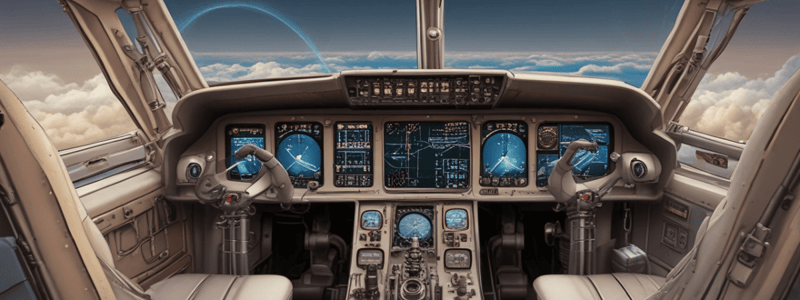Podcast
Questions and Answers
What is the purpose of the follow-up system in an autopilot system?
What is the purpose of the follow-up system in an autopilot system?
- To provide position feedback and return the control surface to neutral (correct)
- To drive the servomotor and control surface to a new position
- To provide the original input signal to the amplifier
- To detect the uncommanded movement of the aircraft
What type of systems does the autopilot mode select panel belong to?
What type of systems does the autopilot mode select panel belong to?
- Sensing element
- Command element (correct)
- Output element
- Computer amplifier
What is the primary function of the computer amplifier in an autopilot system?
What is the primary function of the computer amplifier in an autopilot system?
- To select the autopilot mode
- To detect uncommanded movement of the aircraft
- To move the control surfaces of the aircraft
- To compute, amplify, and process signals from the sensing and command elements (correct)
What is the ultimate goal of the autopilot system's correction process?
What is the ultimate goal of the autopilot system's correction process?
What type of systems do the attitude gyros, rate gyros, accelerometers, and pitot static systems belong to?
What type of systems do the attitude gyros, rate gyros, accelerometers, and pitot static systems belong to?
What is the role of the output element in an autopilot system?
What is the role of the output element in an autopilot system?
What are the possible types of autopilot actuators?
What are the possible types of autopilot actuators?
What is the minimum requirement for an autopilot system?
What is the minimum requirement for an autopilot system?
What is the purpose of using airspeed and altitude information in an autopilot system?
What is the purpose of using airspeed and altitude information in an autopilot system?
What is the function of an angle of attack sensor in an AFCS?
What is the function of an angle of attack sensor in an AFCS?
What is the purpose of a radar altimeter in an AFCS?
What is the purpose of a radar altimeter in an AFCS?
What type of information is provided by inertial navigation systems, radio receivers, and global positioning systems in an AFCS?
What type of information is provided by inertial navigation systems, radio receivers, and global positioning systems in an AFCS?
What is the typical range of overpowering force on the control wheel?
What is the typical range of overpowering force on the control wheel?
What does the trim indicator provide?
What does the trim indicator provide?
What happens when a pointer on the trim indicator remains continuously deflected?
What happens when a pointer on the trim indicator remains continuously deflected?
What is the purpose of the autopilot disengage switch?
What is the purpose of the autopilot disengage switch?
Where are the autopilot disengage switches typically located?
Where are the autopilot disengage switches typically located?
What happens when the servo commands are satisfied?
What happens when the servo commands are satisfied?
What is the normal autopilot engaged mode where the pilot does not touch the controls?
What is the normal autopilot engaged mode where the pilot does not touch the controls?
What is the purpose of the transducer on the control wheel in control wheel steering mode?
What is the purpose of the transducer on the control wheel in control wheel steering mode?
What is the primary function of the Mode Select Panel in an aircraft?
What is the primary function of the Mode Select Panel in an aircraft?
What happens when the pilot applies a reasonable amount of pressure on the respective flight control?
What happens when the pilot applies a reasonable amount of pressure on the respective flight control?
What is the purpose of the Fail Operational feature in an aircraft's autopilot system?
What is the purpose of the Fail Operational feature in an aircraft's autopilot system?
What is the main difference between manual mode and command mode in an autopilot system?
What is the main difference between manual mode and command mode in an autopilot system?
What is the function of the autopilot in control wheel steering mode?
What is the function of the autopilot in control wheel steering mode?
What type of sensing device is used in the control wheel steering transducer?
What type of sensing device is used in the control wheel steering transducer?
What is the relationship between the flight director and the autopilot system?
What is the relationship between the flight director and the autopilot system?
What is the term for the mode where the pilot sets the autopilot to assist in flying the aircraft?
What is the term for the mode where the pilot sets the autopilot to assist in flying the aircraft?
How many autopilot systems can be engaged during normal flight conditions?
How many autopilot systems can be engaged during normal flight conditions?
What navigation modes are selectable through the Mode Select Panel?
What navigation modes are selectable through the Mode Select Panel?
Flashcards are hidden until you start studying
Study Notes
Autopilot System
- Control surface movement causes a change in aircraft attitude, which is then corrected by the sensor output, returning the control surface to its neutral position.
Autopilot Elements
- A basic autopilot consists of sensing, command, and output elements.
- The sensing element detects uncommanded movement of the aircraft about its three flight axes and the rate of that movement.
- The command element includes the autopilot mode select panel, flight controller, control wheel steering, and navigation systems.
- The output element consists of units that move the control surfaces of the aircraft in response to computer demands.
Sensing Elements
- A minimum of pitch and roll attitude, heading information, and airspeed and altitude data are required for autopilot function.
- Additional sensors can improve autopilot function, including pitch, roll, and yaw rate sensing, vertical acceleration, and air data information.
- A fully operational AFCS (Automatic Flight Control System) uses data from inertial navigation systems, radio receivers, global positioning systems, flight management systems, and radar altimeter information.
Command Elements
- The autopilot mode select panel is the primary interface between the flight crew and the automatic flight control systems.
- The panel contains switches and logic circuits for on/off control and mode selection for autopilot/flight director channels and the Autothrottle system.
- The mode-select panel autopilot engage switches have CWS (Control Wheel Steering) in place of MAN (Manual).
Control Wheel Steering
- The pilot can set the autopilot to control wheel steering mode, where the pilot's input is measured and used as an input signal to the flight control computer.
- The autopilot stays engaged and helps to move the control surfaces.
- The transducer on the control wheel converts the input force into an electrical signal.
Autopilot Override
- The pilot can overpower the autopilot at any time by applying a reasonable amount of pressure on the respective flight control.
- A typical overpowering force would be 25 to 35 pounds of turning force on the control wheel or 40 to 50 pounds of force on the control column.
Trim Indicator
- The trim indicator provides a visual display of the magnitude and polarity of the signal being applied to the flight control actuator or servomotor.
- Each pointer represents a primary flight control, and a pointer is deflected each time a servo amplifier command signal is applied to the actuator.
- The pilot can manually trim the aircraft until the pointer returns to the zero position.
Studying That Suits You
Use AI to generate personalized quizzes and flashcards to suit your learning preferences.




